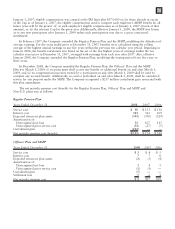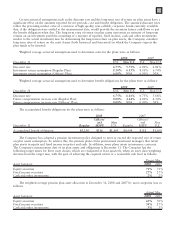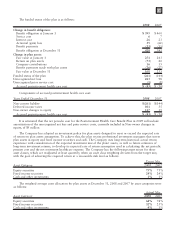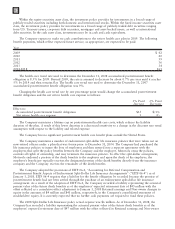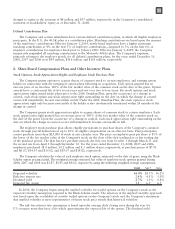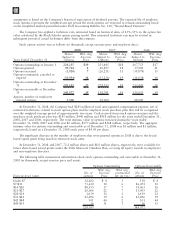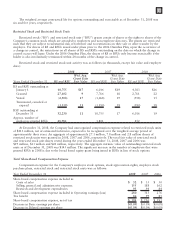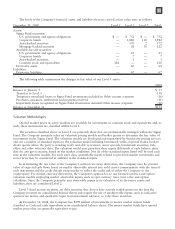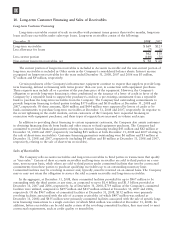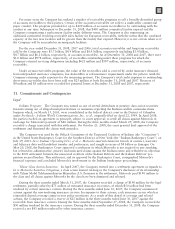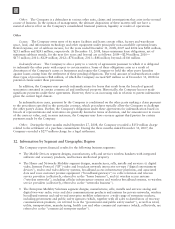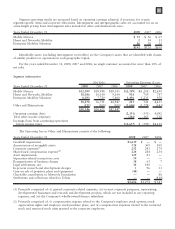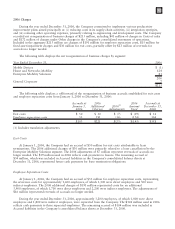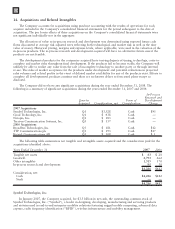Motorola 2008 Annual Report Download - page 124
Download and view the complete annual report
Please find page 124 of the 2008 Motorola annual report below. You can navigate through the pages in the report by either clicking on the pages listed below, or by using the keyword search tool below to find specific information within the annual report.
Motorola Incentive Plan
The Motorola Incentive Plan provides eligible employees with an annual payment, calculated as a percentage
of an employee’s eligible earnings, in the year after the close of the current calendar year if specified business goals
and individual performance targets are met. The provisions for awards under these incentive plans for the years
ended December 31, 2008, 2007 and 2006 were $172 million, $190 million and $268 million, respectively.
Long-Range Incentive Plan
The Long-Range Incentive Plan (“LRIP”) rewards participating elected officers for the Company’s achievement
of specified business goals during the period, based on two performance objectives measured over three-year cycles.
The provision for LRIP (net of the reversals of previously recognized reserves) for the years ended December 31,
2008, 2007 and 2006 was $(13) million, $(8) million and $16 million, respectively. On April 21, 2008, the
Compensation and Leadership Committee of the Board of Directors of Motorola, Inc. approved the cancellation of
the 2006-2008 performance cycle and the 2007-2009 performance cycle under the Company’s Long Range
Incentive Plan of 2006 without the payment of awards for such performance cycles, as reported on Form 8-K, filed
April 25, 2008.
9. Fair Value Measurements
The Company adopted Financial Accounting Standards Board (“FASB”) Statement of Financial Accounting
Standards (“SFAS”) No. 157, “Fair Value Measurements” (“SFAS 157”) on January 1, 2008 for all financial assets
and liabilities and non-financial assets and liabilities that are recognized or disclosed at fair value in the financial
statements on a recurring basis. SFAS 157 defines fair value, establishes a consistent framework for measuring fair
value and expands disclosure requirements about fair value measurements. SFAS 157 does not change the
accounting for those instruments that were, under previous GAAP, accounted for at cost or contract value. In
February 2008, the FASB issued staff position No. 157-2 (“FSP 157-2”), which delays the effective date of
SFAS 157 one year for all non-financial assets and non-financial liabilities, except those recognized or disclosed at
fair value in the financial statements on a recurring basis. The Company has no non-financial assets and liabilities
that are required to be measured at fair value on a recurring basis as of December 31, 2008. Under FSP 157-2, the
Company will apply the measurement criteria of SFAS 157 to the remaining assets and liabilities no later than the
first quarter of 2009.
The Company holds certain fixed income securities, equity securities and derivatives, which must be measured
using the SFAS 157 prescribed fair value hierarchy and related valuation methodologies. SFAS 157 specifies a
hierarchy of valuation techniques based on whether the inputs to each measurement are observable or
unobservable. Observable inputs reflect market data obtained from independent sources, while unobservable inputs
reflect the Company’s assumptions about current market conditions. The prescribed fair value hierarchy and
related valuation methodologies are as follows:
Level 1—Quoted prices for identical instruments in active markets.
Level 2—Quoted prices for similar instruments in active markets, quoted prices for identical or similar
instruments in markets that are not active and model-derived valuations, in which all significant inputs are
observable in active markets.
Level 3—Valuations derived from valuation techniques, in which one or more significant inputs are
unobservable.
116



